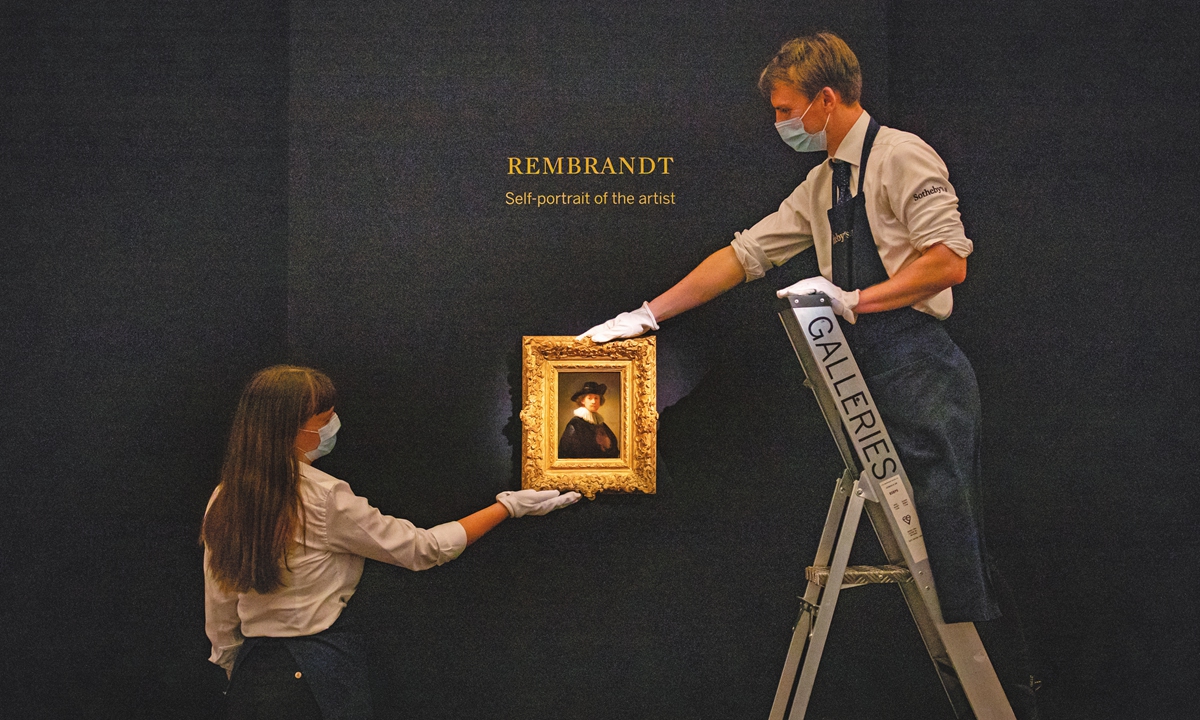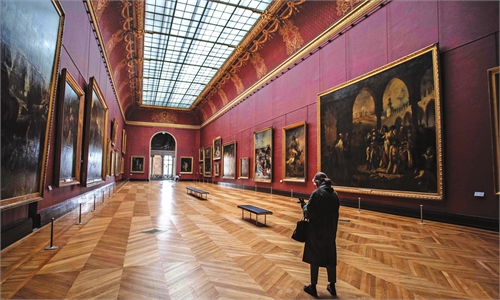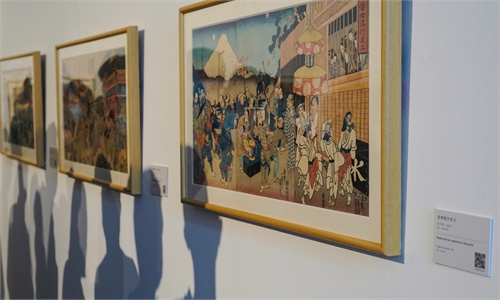ARTS / ART
Art world continues trying to adjust to pandemic
Adapting to survive
The hubbub that descends each summer on a sleek exhibition hall in Basel, where collectors snap up art and hunt for hot-ticket new talent, is likely to be replaced this time by lines of socially distanced Swiss waiting for COVID-19 vaccines.

The art world is reeling from the impact of lockdowns, travel bans and social distancing, and fairs like Art Basel suffered more than most. The business of buying and selling art is having to adapt to limit the damage.
Global art sales fell 22 percent in 2020 to $50.1 billion, UBS and Art Basel's Art Market Report published on Tuesday showed, the steepest market drop since the financial crisis.
But the picture was uneven, as buying by the ultra-wealthy, notably from Asia, held up.
In contrast to the 2007-09 financial crisis, when many of the world's rich lost money, the super-rich have become richer during the pandemic as financial stimulus and volatile markets served to increase their fortunes.
Big auctions houses, led by Sotheby's and Christie's, were already used to telephone bidding and online sales, and so could pivot relatively easily to appeal to cash-rich clients.
Both reported an overall dip but saw record online activity and resilience among Asian buyers, while pre-pandemic trends of interest in black, female and living artists were reinforced.
In 2021, they hope to build on that, capitalizing on an influx of young collectors who have found the online world more accessible than old-style auction rooms, and as more traditional buyers yearn to return to the real world.
"There is enormous pent-up demand for experiences and even spending, once there's a bit more stability and predictability," Sotheby's Chief Executive Charles Stewart told Reuters.
"We have the potential for just the biggest boom for a period of time, assuming that we get to a place where people are comfortable leaving their house."
Rise of digital art
For Christie's, 2021 has seen spectacular confirmation of the potential to create wealth from the virtual world as it hosted a record-breaking $70 million digital artwork sale in March.
In an online auction held over 14 days, bids on the work by US artist Beeple started at $100 and accelerated dramatically, with 22 million visitors tuning in for the final minutes of bidding.
Christie's plans to follow up on the success with further sales of non-fungible tokens (NFTs), or artworks that exist only in digital form.
More people appear to be willing to purchase artworks online without seeing the real thing first.
"What we have observed is the simple behavioral truth that collectors are more willing than ever before to buy from an image," said Rachel Lehmann, cofounder of Lehmann Maupin, which has galleries around the world.
But she added that the digital space presented a challenge for artists and artworks that don't translate well into an online image.
The UBS and Art Basel report found fairs accounted for 43 percent of art dealer sales in 2019 but only 22 percent in 2020, just under half of which were generated by digital events.
"The digital world is concentrating buying on what is fashionable [on social media] and through the big galleries that employ more than 100 people," said James Mayor, who has run the Mayor Gallery in London since taking it over from his father in 1973.
Although he always attended Art Basel, he has avoided its digital offerings, which he says are no substitute for the real-life event. Some others agree.
"So far, digital formats have not replaced this as we benefit from face-to-face interaction and the atmosphere of a physical fair," Stefan von Bartha, director at Basel-based gallery von Bartha, told Reuters.
'Winner-takes-all'
For German artist ANTOINETTE, lockdown was not all bad: The cancelation of public events allowed her an extended stay in the east German castle of Merseburg where she was working.
Using only pencils, she is creating intricate drawings on 5-meter-high panels that form part of a multi-year project on European cultural identity entitled ALTAR of Europe.
Socially distanced locals can watch her work through the windows and ANTOINETTE said they have become her network.
"I've come to feel like a part of the community," the artist told Reuters.
But if she is fulfilled artistically, financially her situation is perilous, as commissions such as portraits have dried up during the pandemic.
Smaller galleries are also struggling, experts say, because the pandemic has accelerated the concentration of the art world into fewer hands - very wealthy buyers and high-profile and established sellers.
"Compared to the last recession, when everybody's wealth went down, in this one billionaire wealth has really risen," art economist Clare McAndrew, who authored the Art Market Report, said.
"These things are good for art sales... But it does bring us back to our old problem of the infrastructure being very top heavy and kind of winner-takes-all."

Gallery assistants hang Self-portrait, wearing a ruff and black hat by Rembrandt during a press preview at Sotheby's in London ahead of their From Rembrandt to Richter sale on July 28, 2020. Photo: VCG
The Herzog & de Meuron building usually hosts one of the world's biggest art fairs in June, but 2020's event was canceled due to the pandemic and 2021's has been moved to September. The adjoining congress center, meanwhile, has been turned into a vaccination hub.The art world is reeling from the impact of lockdowns, travel bans and social distancing, and fairs like Art Basel suffered more than most. The business of buying and selling art is having to adapt to limit the damage.
Global art sales fell 22 percent in 2020 to $50.1 billion, UBS and Art Basel's Art Market Report published on Tuesday showed, the steepest market drop since the financial crisis.
But the picture was uneven, as buying by the ultra-wealthy, notably from Asia, held up.
In contrast to the 2007-09 financial crisis, when many of the world's rich lost money, the super-rich have become richer during the pandemic as financial stimulus and volatile markets served to increase their fortunes.
Big auctions houses, led by Sotheby's and Christie's, were already used to telephone bidding and online sales, and so could pivot relatively easily to appeal to cash-rich clients.
Both reported an overall dip but saw record online activity and resilience among Asian buyers, while pre-pandemic trends of interest in black, female and living artists were reinforced.
In 2021, they hope to build on that, capitalizing on an influx of young collectors who have found the online world more accessible than old-style auction rooms, and as more traditional buyers yearn to return to the real world.
"There is enormous pent-up demand for experiences and even spending, once there's a bit more stability and predictability," Sotheby's Chief Executive Charles Stewart told Reuters.
"We have the potential for just the biggest boom for a period of time, assuming that we get to a place where people are comfortable leaving their house."
Rise of digital art
For Christie's, 2021 has seen spectacular confirmation of the potential to create wealth from the virtual world as it hosted a record-breaking $70 million digital artwork sale in March.
In an online auction held over 14 days, bids on the work by US artist Beeple started at $100 and accelerated dramatically, with 22 million visitors tuning in for the final minutes of bidding.
Christie's plans to follow up on the success with further sales of non-fungible tokens (NFTs), or artworks that exist only in digital form.
More people appear to be willing to purchase artworks online without seeing the real thing first.
"What we have observed is the simple behavioral truth that collectors are more willing than ever before to buy from an image," said Rachel Lehmann, cofounder of Lehmann Maupin, which has galleries around the world.
But she added that the digital space presented a challenge for artists and artworks that don't translate well into an online image.
The UBS and Art Basel report found fairs accounted for 43 percent of art dealer sales in 2019 but only 22 percent in 2020, just under half of which were generated by digital events.
"The digital world is concentrating buying on what is fashionable [on social media] and through the big galleries that employ more than 100 people," said James Mayor, who has run the Mayor Gallery in London since taking it over from his father in 1973.
Although he always attended Art Basel, he has avoided its digital offerings, which he says are no substitute for the real-life event. Some others agree.
"So far, digital formats have not replaced this as we benefit from face-to-face interaction and the atmosphere of a physical fair," Stefan von Bartha, director at Basel-based gallery von Bartha, told Reuters.
'Winner-takes-all'
For German artist ANTOINETTE, lockdown was not all bad: The cancelation of public events allowed her an extended stay in the east German castle of Merseburg where she was working.
Using only pencils, she is creating intricate drawings on 5-meter-high panels that form part of a multi-year project on European cultural identity entitled ALTAR of Europe.
Socially distanced locals can watch her work through the windows and ANTOINETTE said they have become her network.
"I've come to feel like a part of the community," the artist told Reuters.
But if she is fulfilled artistically, financially her situation is perilous, as commissions such as portraits have dried up during the pandemic.
Smaller galleries are also struggling, experts say, because the pandemic has accelerated the concentration of the art world into fewer hands - very wealthy buyers and high-profile and established sellers.
"Compared to the last recession, when everybody's wealth went down, in this one billionaire wealth has really risen," art economist Clare McAndrew, who authored the Art Market Report, said.
"These things are good for art sales... But it does bring us back to our old problem of the infrastructure being very top heavy and kind of winner-takes-all."



